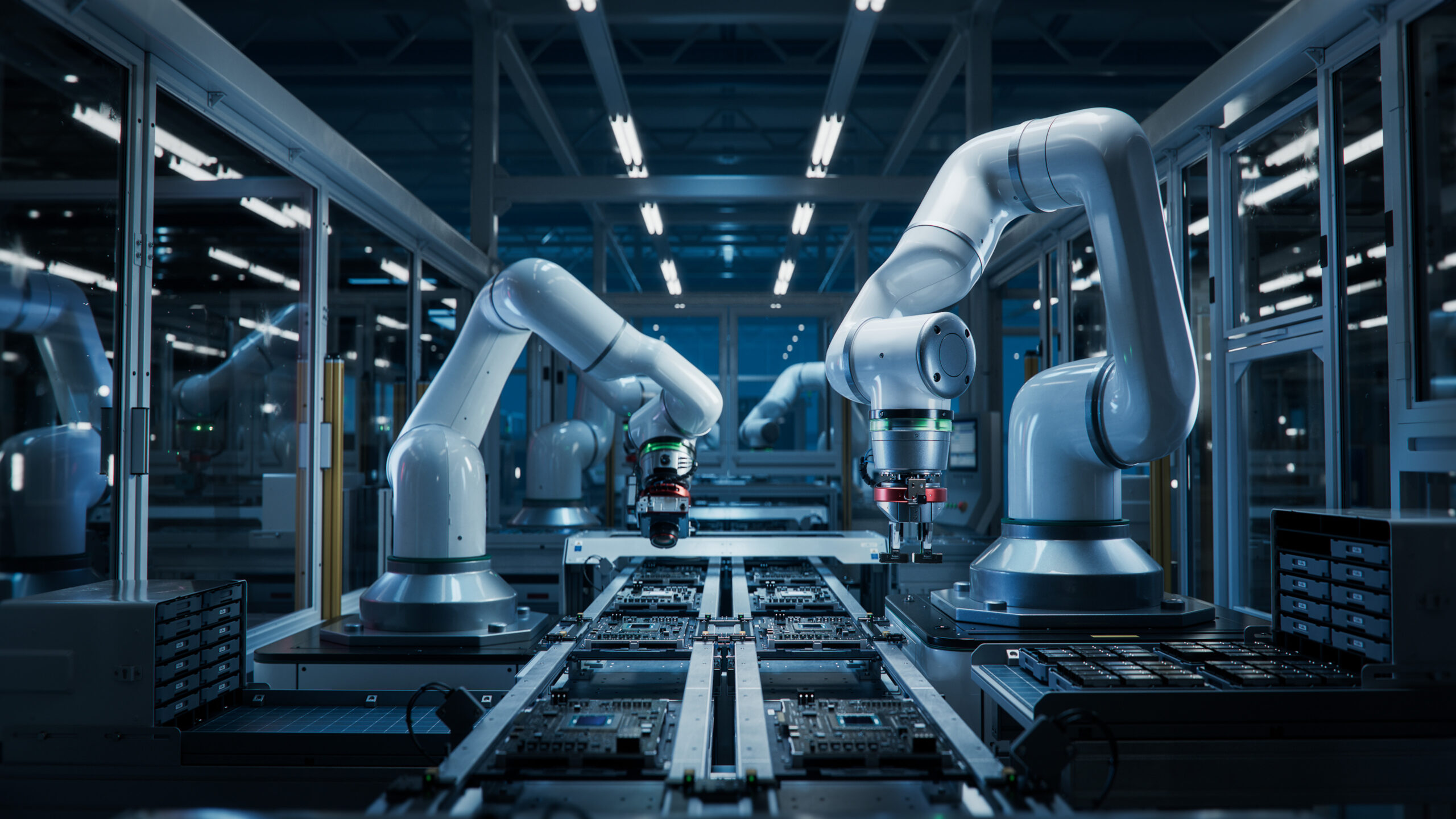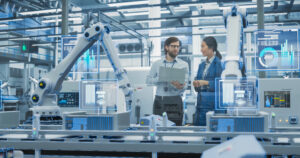Revolutionizing Discrete and Smart Manufacturing with Advanced Automation and Data Insights
Manufacturing: The Story So Far
The first Industrial Revolution was above all a technological revolution, with innovations such as mechanized cotton spinning, coke-fired blast furnaces, steam engines and machine tools driving rapid change. Manufacturing has gone through a further three industrial revolutions, each of them also driven by technological change. The second saw the application of electrification and powerful engines (among many other innovations) to raise productivity. Then the third saw the birth of the information age; the fourth, or Industry 4.0, is marked by the comprehensive digitalization of industrial production, with data exchange between machines, devices, sensors and human beings.
Thus, in the current era, machines improve human efficiency by performing repetitive functions. And the combination of machine learning, artificial intelligence algorithms, big data and computing power allows machines to carry out increasingly complex tasks.
In this article we briefly explore some overlapping related concepts, and the relevant terminology, techniques and technologies.
Smart Manufacturing & Smart Factories
Smart Manufacturing refers to the use of advanced technologies—such as AI, IoT, robotics, and data analytics—to optimize manufacturing processes, increase efficiency, and enable real-time decision-making across the production lifecycle.
While smart manufacturing refers to the overarching approach or strategy, a smart factory is the physical embodiment of that strategy—where those technologies are actually implemented to create an intelligent and interconnected production environment.
A smart factory is characterized by adaptability, resource efficiency, optimized ergonomics and the integration of customers, suppliers and business partners in business and value processes. Its technological foundation consists of cyber-physical systems (CPS) and the Internet of Things (IoT).
Cyber-physical systems combine the physical world with the virtual world of the internet. They are made up of physical components such as sensors and actuators, and software and network technologies.
The Internet of Things is a network of connected devices and objects that can exchange data. IoT devices are equipped with sensors, software and other technologies.
The use of the term smart manufacturing has emerged over time in the early 21st century. Some of its concepts and technologies, such as computer-integrated manufacturing (CIM) and lean production predate the term. In the early 2010s the term gained traction, especially in the US, around the same time Germany introduced Industry 4.0 (in 2011) as a top-down strategic initiative to promote digital transformation in industry.
Thereafter, smart manufacturing came to be used more formally, particularly in the context of US industrial strategy. The Smart Manufacturing Leadership Coalition (SMLC) in the US played a key role in promoting the term.
Discrete Manufacturing
Unlike smart manufacturing, discrete manufacturing refers to the production of distinct, countable items such as automobiles, furniture, smartphones, and airplanes. Discrete manufacturing is thus distinguished from process manufacturing, which is the production of non-countable commodities such as food ingredients, chemicals, cement etc.
While the core definition has remained stable, the methodologies and technologies employed in discrete manufacturing have evolved significantly, especially with the advent of automation, robotics, and digital manufacturing technologies. These advancements have enhanced efficiency, precision, and customization in the production of discrete items.
Discrete Manufacturing & Smart Manufacturing
Smart manufacturing has paved the way to mass customization, which has stretched the boundaries of discrete manufacturing. Whereas discrete manufacturing was originally about producing standardized, countable units, now the same processes can produce distinct, individualized items at scale, thanks to digital tools such as configurable product platforms, AI-driven design-to-order systems, flexible manufacturing systems (FMS) and additive manufacturing (3D printing).
So, while the core idea of discrete manufacturing still applies, the variation and personalization possible within that framework have expanded dramatically. It’s one of the reasons smart manufacturing and Industry 4.0 are such game-changers—they make that kind of flexibility commercially viable.
Technologies Driving Smart Manufacturing
Smart manufacturing not only provides a further massive boost to productivity but also facilitates the flexibility to shift production in response to changes in demand. The enabling technologies include:
- Big data processing and data analytics to optimize complex production processes and enhance supply chain management.
- Cloud computing allows a large amount of data on machine performance and output quality to be collected. This can improve machine configuration, predictive maintenance, and fault analysis. Better predictions facilitate the planning of more efficient strategies for ordering raw materials or scheduling production runs.
- Artificial intelligence is deployed in virtually all aspects of manufacturing. It uses machine learning and deep learning algorithms to improve quality control, support predictive maintenance, automate work order generation and optimize task sequencing, assembly lines and inventory. AI eliminates many of the routine tasks in manufacturing, which is now essential to maintain competitiveness, especially in regions with high labor costs.
- Advanced industrial robots operate autonomously and communicate directly with manufacturing systems. Automated and programmable industrial robots, capable of movement on several axes, were introduced before Industry 4.0 as a concept. However, advanced industrial robots, equipped with visual sensors and powered by artificial intelligence, can evaluate sensory input and distinguish between different product configurations, solving problems and making decisions independent of human input.
- Additive manufacturing or 3D printing technology started out as a method for rapid prototyping, but today it has much broader applications, especially in the automotive, industrial and medical manufacturing sectors. In the automotive industry, 3D printing is used not only for prototyping but also for the full production of final parts and products. Custom jigs, fixtures, and molds can be made quickly and cost-effectively, increasing production flexibility and reducing downtime. It is especially effective for motorsport or luxury segments (e.g. Bugatti uses additive manufacturing for titanium brake calipers). Spare parts for discontinued models can also be manufactured on demand. A further benefit is lightweighting. 3D printing enables complex geometries that reduce weight without sacrificing strength (which is important for EV range and performance). In medical applications, 3D printing enables the manufacture of orthopedic implants (e.g. hips, knees and spinal cages) tailored to the patient’s anatomy using CT scan data. In dentistry, crowns, bridges, aligners, and dentures are routinely 3D printed. Additive manufacturing is also used for the production of customized medical equipment and surgical instruments.
- Digital twins enable manufacturers to virtualize and represent the physical production of objects as digital twin models (avatars). Since digital twins mirror a product’s entire lifecycle, they have become ubiquitous in all stages of manufacturing, guiding products from design to finished product, and all steps in between. Digital twins are extensively used in automotive design, both to improve vehicle performance and increase the efficiency surrounding their production.
Strategies for Transitioning to Smart Manufacturing
Transitioning a production facility to smart manufacturing is a challenge, and it will not happen overnight. However, many companies must start now to keep up with, or surpass, their competitors. In the current global economic environment, we may see large manufacturing concerns reshoring their operations in smart factories as this becomes a more efficient alternative to reliance on low-cost countries.
Rather than focusing on individual technologies, it’s best to approach the challenge holistically by updating or implementing a smart manufacturing execution system (MES). Here are three essential first steps to guide your transition:
- Assess your current system
Evaluate strengths, weaknesses, bottlenecks, and integration with other systems.
- Set clear goals
Define how you want to improve efficiency, data management, and scalability.
- Choose a migration strategy
Select a strategy suited to your organization’s size and complexity. One option is to replace the old MES entirely with a new system.
The Manufacturing Enterprise Solutions Association (MESA), a non-profit, can support manufacturers throughout the transition, helping improve results along the way.
The Future of Discrete Manufacturing
Industry 4.0 was only introduced in 2011, yet visionaries and practitioners are already looking ahead to the next phase in discrete manufacturing: Industry 5.0, with mass customization at its core.
Industry 5.0 takes a human-centric approach. It shifts the focus from purely digital advancement to one that prioritizes individual and societal needs. This is already evident in the custom manufacture of orthopedic implants, but the concept could extend to other sectors—such as food production tailored to an individual’s circumstances, including their genetic profile.
In this model, AI is used to understand human needs and desires, applying that insight to design products that meet them. Information technology and automation are critical enablers, linking customer preferences directly to a manufacturer’s ability to deliver personalized goods.
Digital twins and additive manufacturing empower customers to take part in product creation, fostering greater engagement. By leveraging these technologies, businesses can eliminate guesswork and let consumers tailor products to their exact specifications. Smart manufacturing systems—particularly in supply chain and inventory management—help ensure timely delivery, even for bespoke items.
While the technical challenges of mass customization are being addressed, its economic viability at scale remains uncertain. Healthcare providers might pay a premium for a perfect-fit hip implant, and the ultra-wealthy might commission a one-off sports car. But are we, as consumers, truly ready—and able—to pay more for personalized versions of everyday items?




